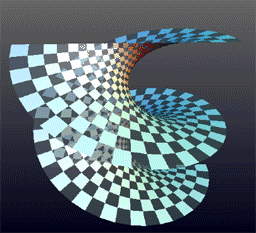Transmitter power output: Difference between revisions
No edit summary |
en>Addbot |
||
| Line 1: | Line 1: | ||
[[Image:Catenoid.svg|thumb|right|A catenoid]] | |||
A '''catenoid''' is a [[surface]] in 3-dimensional Euclidean space arising by rotating a [[catenary]] [[curve]] about its directrix. Not counting the plane, it is the first [[minimal surface]] to be discovered. It was found and proved to be minimal by [[Leonhard Euler]] in 1744.<ref>L. Euler, Methodus inveniendi lineas curvas maximi minimive proprietate gaudentes, 1744, in: Opera omnia I, 24</ref> Early work on the subject was published also by [[Jean Baptiste Meusnier]].<ref>Meusnier, J. B. "Mémoire sur la courbure des surfaces." Mém. des savans étrangers 10 (lu 1776), 477-510, 1785</ref> There are only two [[minimal surfaces of revolution]] ([[surfaces of revolution]] which are also minimal surfaces): the [[plane (geometry)|plane]] and the catenoid.<ref>[http://mathworld.wolfram.com/Catenoid.html Catenoid at MathWorld]</ref> | |||
The catenoid may be defined by the following parametric equations: | |||
:<math>x=c \cosh \frac{v}{c} \cos u</math> | |||
:<math>y=c \cosh \frac{v}{c} \sin u</math> | |||
:<math>z=v</math> | |||
:where u and v are real parameters and c is a non-zero real constant. | |||
In cylindrical coordinates: | |||
:<math>\rho =c \cosh \frac{z}{c}</math> | |||
:Where c is a real constant. | |||
A physical model of a catenoid can be formed by dipping two [[circle]]s into a soap solution and slowly drawing the circles apart. | |||
The catenoid may be also defined approximately by the [[Stretched grid method]] as a facet 3D model | |||
== Helicoid transformation == | |||
[[Image:helicatenoid.gif|thumb|right|256px|Animation showing the deformation of a helicoid into a catenoid.]] | |||
Because they are members of the same [[associate family]] of surfaces, one can bend a catenoid into the shape of a [[helicoid]] without stretching. In other words, one can make a [[continuous function|continuous]] and [[Isometry|isometric]] deformation of a catenoid to a [[helicoid]] such that every member of the deformation family is [[Minimal surface|minimal]] (having a [[mean curvature]] of zero). A [[Parametric equation|parametrization]] of such a deformation is given by the system | |||
:<math>x(u,v) = \cos \theta \,\sinh v \,\sin u + \sin \theta \,\cosh v \,\cos u</math> | |||
:<math>y(u,v) = -\cos \theta \,\sinh v \,\cos u + \sin \theta \,\cosh v \,\sin u</math> | |||
:<math>z(u,v) = u \cos \theta + v \sin \theta \,</math> | |||
:for <math>(u,v) \in (-\pi, \pi] \times (-\infty, \infty)</math>, with deformation parameter <math>-\pi < \theta \le \pi</math>, | |||
where | |||
<math>\theta = \pi</math> corresponds to a right-handed helicoid, | |||
<math>\theta = \pm \pi / 2</math> corresponds to a catenoid, and | |||
<math>\theta = 0</math> corresponds to a left-handed helicoid. | |||
==References== | |||
<references/> | |||
==External links== | |||
*{{springer|title=Catenoid|id=p/c020800}} | |||
*[http://www.mathcurve.com/surfaces/catenoid/catenoid.shtml "Caténoïde" at Encyclopédie des Formes Mathématiques Remarquables] (in French) | |||
*[http://www.princeton.edu/~rvdb/WebGL/catenoid.html Animated 3D WebGL model of a catenoid] | |||
[[Category:Minimal surfaces]] | |||
[[de:Minimalfläche#Die Katenoiden]] | |||
Revision as of 03:18, 7 March 2013

A catenoid is a surface in 3-dimensional Euclidean space arising by rotating a catenary curve about its directrix. Not counting the plane, it is the first minimal surface to be discovered. It was found and proved to be minimal by Leonhard Euler in 1744.[1] Early work on the subject was published also by Jean Baptiste Meusnier.[2] There are only two minimal surfaces of revolution (surfaces of revolution which are also minimal surfaces): the plane and the catenoid.[3]
The catenoid may be defined by the following parametric equations:
- where u and v are real parameters and c is a non-zero real constant.
In cylindrical coordinates:
- Where c is a real constant.
A physical model of a catenoid can be formed by dipping two circles into a soap solution and slowly drawing the circles apart.
The catenoid may be also defined approximately by the Stretched grid method as a facet 3D model
Helicoid transformation

Because they are members of the same associate family of surfaces, one can bend a catenoid into the shape of a helicoid without stretching. In other words, one can make a continuous and isometric deformation of a catenoid to a helicoid such that every member of the deformation family is minimal (having a mean curvature of zero). A parametrization of such a deformation is given by the system
where corresponds to a right-handed helicoid, corresponds to a catenoid, and corresponds to a left-handed helicoid.
References
- ↑ L. Euler, Methodus inveniendi lineas curvas maximi minimive proprietate gaudentes, 1744, in: Opera omnia I, 24
- ↑ Meusnier, J. B. "Mémoire sur la courbure des surfaces." Mém. des savans étrangers 10 (lu 1776), 477-510, 1785
- ↑ Catenoid at MathWorld
External links
- Other Sports Official Kull from Drumheller, has hobbies such as telescopes, property developers in singapore and crocheting. Identified some interesting places having spent 4 months at Saloum Delta.
my web-site http://himerka.com/ - "Caténoïde" at Encyclopédie des Formes Mathématiques Remarquables (in French)
- Animated 3D WebGL model of a catenoid







![{\displaystyle (u,v)\in (-\pi ,\pi ]\times (-\infty ,\infty )}](https://wikimedia.org/api/rest_v1/media/math/render/svg/69bd6d31446bbbbdb601db5ced84afb267ec09fb)



